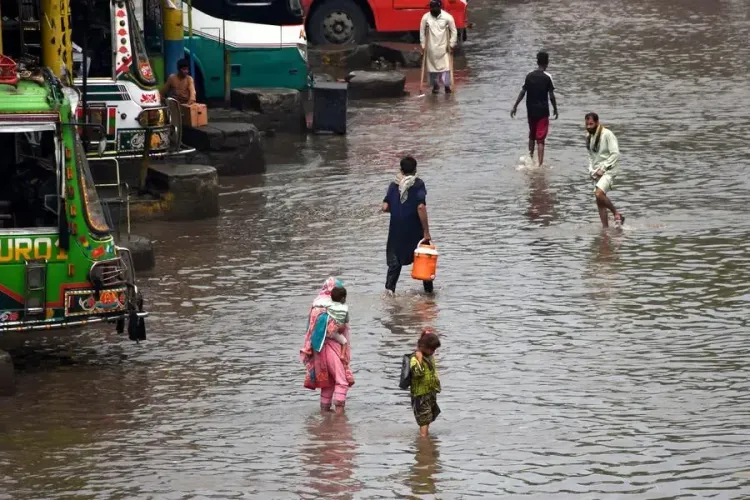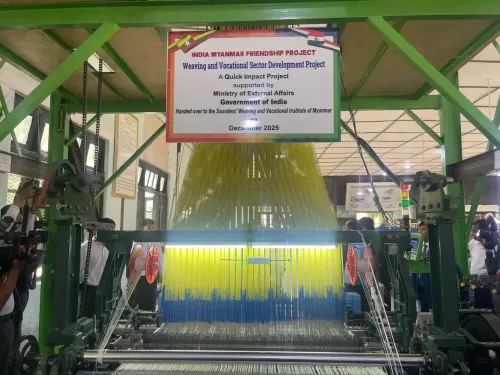Is Pakistan Prepared for Floods as Monsoon Unleashes Chaos?

Synopsis
Key Takeaways
- Authorities have issued alerts for heavy rainfall and flooding across Pakistan.
- 98 lives lost and 185 injured due to monsoon-related incidents.
- Residents in flood-prone areas are urged to prepare evacuation plans.
- Ongoing monsoon activity is expected to intensify rainfall.
- Temporary shelters have been established for evacuees.
Islamabad, July 12 (NationPress) As a relentless monsoon system persists over Pakistan, officials have released multiple alerts indicating moderate to heavy rainfall, escalating river flows, and the risk of flash floods in susceptible regions. The National Disaster Management Authority (NDMA) and Punjab's Provincial Disaster Management Authority (PDMA) have encouraged inhabitants to stay alert and steer clear of low-lying and flooded areas, particularly since these warnings are effective until July 17.
The ongoing monsoon activity, bolstered by moisture from the Arabian Sea, is significantly impacting Punjab, where sporadic rains in Lahore have led to increased humidity levels.
As reported by NDMA, catastrophic monsoon rains and subsequent flash floods have resulted in at least 98 fatalities and left 185 individuals injured nationwide since June 26.
Punjab has recorded the highest fatalities with 37 deaths, including 20 children, while Khyber Pakhtunkhwa has seen 30 casualties.
The Pakistan Meteorological Department (PMD) forecasts that temperatures in Lahore will fluctuate between a low of 27 Degrees Celsius and a high of 33 Degrees Celsius.
Light rainfall is anticipated in the city, prompting PDMA to issue a warning for rain and strong winds until July 17.
NDMA's National Emergency Operations Centre has provided a hydrological forecast for July 13 to 17, indicating widespread rainfall that may intensify due to the current monsoon system.
According to alerts, all major rivers, including the Indus, Kabul, Jhelum (upstream of Mangla), and Chenab, are expected to experience increased flows due to incoming western winds, as reported by the leading Pakistani newspaper, The Express Tribune.
Flash floods are anticipated in Balochistan's districts of Jhal Magsi, Kachhi, Sibi, Killa Saifullah, Zhob, and Musakhel, with localised flooding threats in Khuzdar, Awaran, Lasbela, and Kalat in southern Balochistan.
Residents living near rivers, nullahs, and drainage channels are advised to remain vigilant, especially during heavy rain and at night when flooding is more likely. Communities in flood-prone areas should plan safe evacuation routes and elevate valuable items, vehicles, and livestock to higher ground.
District administrations in northeastern and central Punjab have been instructed to keep dewatering equipment ready to tackle potential urban flooding.
The NDMA's monsoon alert also applies to Karachi, where the ongoing weather system may further escalate due to moisture from the Arabian Sea. The hydrological outlook anticipates high to very high river flows in various regions due to western wind activity.
In Islamabad, forecasts are consistent with alerts for other areas: Tarbela, Taunsa, and Guddu are at low flood levels, while Kalabagh and Chashma are facing moderate flooding, with water levels at Taunsa expected to rise further.
In Khyber Pakhtunkhwa, ongoing rainfall has heightened the risk of flash floods in the tributaries of Swat and Panjkora. Heavy rainfall on Thursday night in Charsadda, Tangi, and surrounding areas caused the Jendi River to overflow.
In response to rising water levels at the Playi Dam, spillways were opened, discharging approximately 8,000 cusecs of water into the river.
The resulting flood caused damage to a bridge and a gas pipeline in Tangi tehsil, according to the prominent Pakistani daily, Dawn.
The district administration has repurposed 53 government schools into temporary shelters for evacuees. Vehicles from various agencies, including the Tehsil Municipal Administration (TMA), are currently being utilized to evacuate residents from affected zones.










